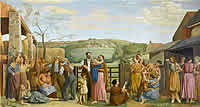

 Hover over the painting to magnify (there may be an initial delay while the magnified image is loaded)
Hover over the painting to magnify (there may be an initial delay while the magnified image is loaded)Stanley Lewis (1905 - 2009):
Study for the Central Group of Allegory, c. 1929
Unframed (ref: 1506)
Oil on canvas,
117 x 57 in. (287x 144.8 cm.)
See all works by Stanley Lewis oil big pictures murals 1.PORTRAIT OF AN ARTIST Golden Generation RCA Stanley Lewis Revisited Welsh Artists and Pictures Works in Progress
Provenance: The Artist's Estate; Private Collection
Literature: The Unknown Artist: Stanley Lewis and his contemporaries, Cecil Higgins Art Gallery & Bedford Museum, 12th June - 5th September 2010, Liss Fine Art, 2010.
Llewellyn, Sacha, and Paul Liss. Portrait of an Artist. Liss Llewellyn, 2021, p.365.
Exhibited: The Unknown Artist: Stanley Lewis and his contemporaries, Cecil Higgins Art Gallery & Bedford Museum, 12th June - 5th September 2010..cat.no.23
”The theme of this painting is man and nature - symbolized by the man holding the hedgehog – living in harmony.….. The hedgehog represents the extraordinary life in the countryside. The pictures theme is a celebration of simple country, country life and animals big and small."

Candidates for the Rome Scholarship were required to submit two figure compositions in colour designed for a wall decoration and a full-size cartoon for a portion of one of these. Lewis completed Allegory whilst staying with his Aunt Joan in Westgate
Terrace, London. Here he found the model for the central figure – a road sweeper who happened to be passing. ‘I looked out of the window and saw a tall man cleaning the street so I got him to pose for a few minutes just so I could get the hang of it.’ Sally’s daughter Joan modelled for the girl with the apple. A review of the finalists (undated newspaper clipping) was criticalof the fact that ‘…..there is now some danger of competitors cultivating a Rome Scholarship style, to please the assessors. That the British School at Rome should stand for the classical tradition in art is natural and proper, but classical principles ought not to be confused with classical reminiscences. Take away the reflections of Piero della Francesca and Michelangelo from some of the designs, and there is not very much left.’
 Rome Scholars
Rome Scholars




